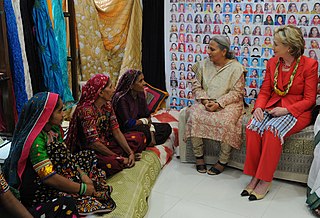Models by country
Community banking looks very different in individual settings or within unique groups.
United States
In the United States, community banks are a common institution. The US tends to follow a more traditional money-lending model in this way, but still incorporates collective ideals in that the community banks are locally owned. They remain specific to individual neighborhoods, and are thus more able to respond to community needs. [6]
India
In India, community banking looks very different. Self-Help Groups (SHG) are often instituted in which members of the local community join together and pool capital resources for the purpose of lending to members. Sometimes, the Self-Help Group is backed by a non-profit organization or even a government-backed bank, but this is not always the case. Self-Help Groups are small, with homogeneous membership, and high attendance rates. They value transparency in their practices and utilizing their savings for the purposes of lending. Because the borrowers are members of the SHG, they tend to experience lower interest rates, greater understanding should they have trouble repaying the loan, and greater flexibility overall. This model is closely linked to tenets of both social work in general and community organizing in particular, wherein each person is regarded with dignity and seen as a force for change. Community banking, in this model, is initiated and organized by the collective rather than an outside institution (as is the case in more traditional models), and thus reflects the power of individuals in creating social change. [7]
Nigeria
Another community banking model in Nigeria is the Credit Development Division. The need for a community banking model arose out of the desire to lessen the gap of credit accessibility in rural areas and to stimulate the economy. Employees in the Division are given the responsibility of planning and implementing credit programs to customers, coordinating alongside community members and other local bodies in order to distribute lines of credit and offering savings opportunities, develop credit tools focusing on security, down-payments, loan repayment periods, and interest and fees. A key component of this approach is that the target customers of the community banks were farmers. Ultimately the goal was to increase productivity and establish a better market for their products. In this model, the bank invests directly into a project without the use of a middle man or negotiator. [8]
Tanzania
The Tanzanian government in collaboration with SEDIT (Social and Economic Development Initiative of Tanzania) implemented a tool called Village Community Banks, or VICOBA. Development of this model included four key elements: group formation, governance, bank operations, and capacity building. Residents in several pre-selected villages voluntarily joined a group consisting of 30 members and then determined the rules and regulations of how the community bank would function. Once members completed the training sessions they could begin to take out loans predetermined projects. During the first few months members can take out short term loans and once they have developed entrepreneurship skills, they can take out longer term loans of up to six months. Lastly, SEDIT provided technical skills to participants over a period of fourteen to sixteen months. Training focused on the forming and regulating of a VICOBA group, how to create group guidelines and resolve conflicts, regulations on running savings and credit transactions in addition to entrepreneurial skills. [9]
Ecuador

In 1999, Peace Corps Ecuador piloted the community banking program Programa de Ahorro y Crédito (PAC), which was adapted from a similar program in Niger called Mata Masu Dubara (Women Moving Ahead). A study of the program was conducted in 2010 from the nonprofit Freedom from Hunger, which evaluated two community banking programs in Ecuador. Participants in the banks were surveyed to determine the effectiveness of the local banking approach. Results showed the most common uses for loan funds were related to health care, investments in business and agricultural enterprises, as well as expenses for home improvements and school. The study found that half of community banks stored their money in a cashbox and nearly a third put the funds in a bank account in the name of one group member (See Fig. 1). [10]








